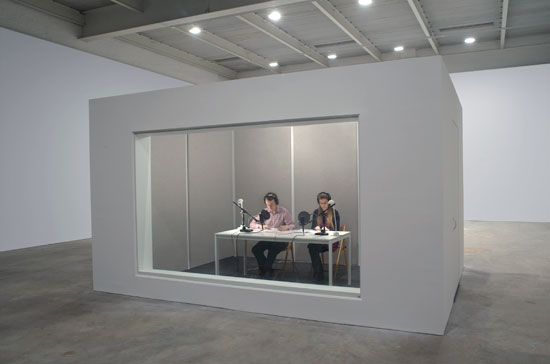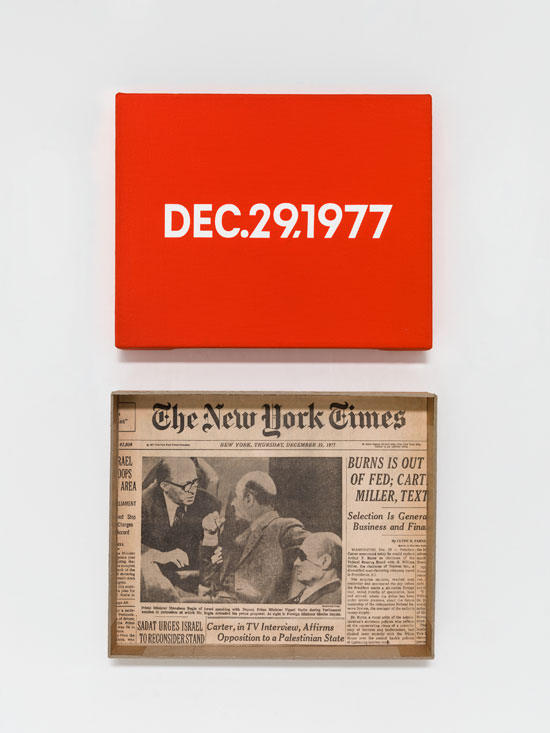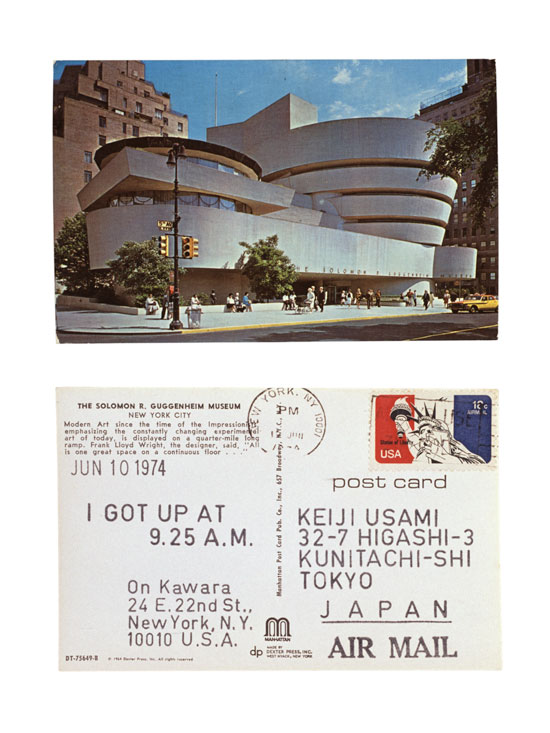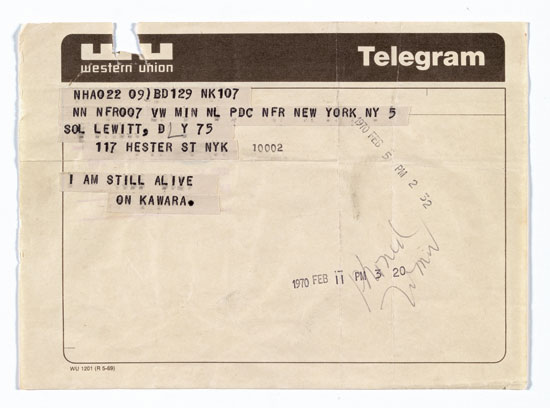The Solomon R. Guggenheim Museum presents the first comprehensive exhibition of work by On Kawara (1933–2014). "On Kawara—Silence" is the broadest representation of Kawara's practice since 1963. Opening on February 6, the exhibition invites the viewer to consider a complex body of work that engages the nature and experience of time and place. The show continues through May 3, 2015.
Artwork can be found along the spiral ramps of the museum and presented in a framework of 12 sections, or “chapters,” according to the museum. The chapters were devised by the artist and include every category of On Kawara artworks, made from 1963 through 2013. Many were produced during his travels across the world.
"On Kawara—Silence" is organized by Jeffrey Weiss, Senior Curator, Solomon R. Guggenheim Museum, with Anne Wheeler, Assistant Curator, Solomon R. Guggenheim Museum, in close cooperation with the artist.
Weiss explained in an exhibition release that Kawara’s work represents an expansive practice; a field of operations and activities that occurred over time according to remarkably consistent terms: “The artist believed the best way for us to engage his work was by direct encounter, through which we can discover its relevance to our own lives.”
Works in "On Kawara—Silence" include monochrome Date Paintings (from the Today series); telegrams (the I Am Still Alive series); stamped tourist postcards (the I Got Up series); city maps marked with the route taken by the artist on a given day (the I Went series); lists of names of people encountered that day (the I Met series); newspaper cuttings (the I Read series); a complete inventory of paintings (the Journals); and vast calendars (One Hundred Years and One Million Years).
Numerous drawings produced in Paris and New York in 1964, which are fascinating proposals for unrealized works, and Kawara’s only two extant paintings of 1965, Location and Title, which herald the Today series, offer a historical perspective and indicate the emergence of the pictorial idiom Kawara continued throughout his career.
The exhibition also presents three months of consecutive Today paintings, identified by the artist collectively as Everyday Meditation, part of which was displayed in the 1971 Guggenheim International Exhibition. As part of the One Million Years project, a continuous live recitation of dates from an immense ledger will occur three days a week during the run of the exhibition on the ground floor of the Guggenheim rotunda.
.

"One Million Years, 1993–" by On Kawara. Live Reading: One Million Years, David Zwirner, New York, January 14–February 14, 2009. Photo: Courtesy David Zwirner, New York/London.
.
Born in Kariya, Japan, On Kawara achieved early recognition in the 1950s as a young member of the Tokyo avant-garde. The artist left Japan in 1959, moving to Mexico City and then to Paris before settling in New York City. During that period of relocation, he abandoned his early surrealistic representations of the body. In 1966 his practice acquired the form it would take thereafter—the intermittent yet persistent production of paintings and other works, most of which serve to identify the time and place of the artist’s whereabouts on the day they were made.
At the heart of "On Kawara—Silence" are paintings from the Today series, created over the course of seven decades according to intensive protocols. With each painting, the date is inscribed in white acrylic against a monochromatic ground in variants of blue, red, or very dark gray, in the language of the place where the painting was made. The strict range of dimensions for the Date Paintings is preordained, and the process of making them is seemingly mechanical, although the paintings were, in fact, meticulously produced by hand. A painting was either finished in the course of a given day or destroyed. On some days, two, and, very occasionally, three, were made.
The exhibition presents over 150 Date Paintings, many accompanied by the handmade storage boxes that Kawara often lined with cuttings from the daily press. Such cuttings, representing topics both historical and banal—politics, natural disaster, celebrity, space exploration, sports—place Kawara’s work in a context of current events, although any logic of selection is difficult to discern.
.

"Dec 29, 1977" "Thursday." by On Kawara. New York, From Today, 1966-2013. Acrylic on canvas, 8 x 10 inches. Pictured with artist-made cardboard storage boxes, 10 1/2 x 10 3/4 x 2 inches. Private collection. Photo: Courtesy David Zwirner, New York/London.
.
“I Got Up.” “I Went.” “I Read.” “I Met.”
Much of Kawara’s work deploys such first-person declarations, which seem to designate little more—yet nothing less—than his very being in the world. More than 1,500 tourist postcards, addressed, stamped, and mailed to friends and acquaintances including artists, gallerists, collectors, critics, and curators such as John Baldessari, Germano Celant, Herman Daled, Kasper König, Sol LeWitt, Lucy Lippard, Toshiaki Minemura, and Adrian Piper bearing the message “I GOT UP AT,” followed by the precise time Kawara began his day, are featured in "On Kawara—Silence".
The exhibition also includes city maps upon which the artist traced his route in a single day, and more than 100 telegrams delivered between 1969–2000, each bearing the simple message “I AM STILL ALIVE.” These series, produced according to their own set of rules, record the basic activities of the artist’s life. Like the Date Paintings, they appear to be purely systematic.
While close examination reveals the work’s unexpectedly personal qualities—not least the discipline and endurance implied by the artist’s relentless record keeping—indications of personal experience are elusive. Throughout his lifetime, the artist’s official biography consisted only of the number of days he had been alive. The schematic nature of his oeuvre means that, despite its subjective nature and focus on self-examination, it remained surprisingly abstract.
.

"JUN 10 1975" by On Kawara. From "I Got Up," 1968–79. Stamped ink on postcard, 3 1/2 x 5 1/2 inches. Collection of Keiji and Sawako Usami.
.

"Telegram to Sol LeWitt, February 5, 1970" by On Kawara. From "I Am Still Alive," 1970–2000. Telegram, 5 3/4 x 8 inches. LeWitt Collection, Chester, Connecticut.
.
Kawara said very little about his art and preferred to leave much about it unexplained, according to the Guggenheim. He did identify one central theme: human consciousness, an individual’s heightened awareness of his or her existence in the world. Kawara also said that a Date Painting represents a paradox—that each painting forever signifies the present by bearing the name and date of the day it was made, yet once the day is over, that present belongs only to the past.
BASIC FACTS: "On Kawara - Silence" opened February 6 and remains on view through May 3, 2015. The Guggenheim is located at 1071 5th Avenue, New York, NY 10128. www.guggenheim.org.
__________________
Copyright 2015 Hamptons Art Hub LLC. All rights reserved.
